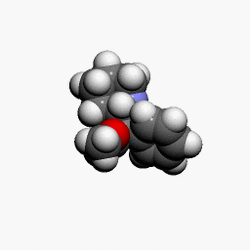Methylphenidate
Methylphenidate (trade names Concerta, Methylin, Ritalin, Equasym XL) is a stimulant drug and substituted phenethylamine approved for treatment of attention-deficit hyperactivity disorder (ADHD) and narcolepsy. It is often used by students to enhance their mental abilities, improving their concentration and helping them to study.
This substance was first licensed by the U.S. Food and Drug Administration (FDA) in 1955 for treating what was then known as hyperactivity. Prescribed to patients beginning in 1960, the drug became heavily prescribed in the 1990s, when the diagnosis of ADHD itself became more widely accepted.[1][2]
Chemistry
Pharmacology
Methylphenidate primarily acts as a dopamine-norepinephrine reuptake inhibitor. It is most active at modulating levels of dopamine and to a lesser extent norepinephrine.[3] Methylphenidate binds to and blocks dopamine transporters and norepinephrine transporters.[4]
While both amphetamine and methylphenidate are dopaminergic, it should be noted that their methods of action are distinct. Specifically, methylphenidate is a dopamine reuptake inhibitor while amphetamine is both a releasing agent and reuptake inhibitor of dopamine and norepinephrine. Each of these drugs has a corresponding effect on norepinephrine which is weaker than its effect on dopamine. Methylphenidate's mechanism of action at dopamine-norepinephrine release is still debated, but is fundamentally different from most other phenethylamine derivatives, as methylphenidate is thought to increase general firing rate, whereas amphetamine reduces firing rate and reverses the flow of the monoamines via TAAR1 activation.[5][6][7][8]
Subjective effects
Physical Effects
The physical effects of methylphenidate can be broken down into 4 components all of which progressively intensify proportional to dosage. These are described below and generally include:
- Stimulation In terms of its effects on the physical energy levels of the user, methylphenidate is usually considered to be energetic and stimulating in a fashion that is distinct but much weaker than that of amphetamine or methamphetamine, but stronger than that of modafinil and caffeine. At lower to moderate doses it encourages general productivity but at higher dosages it encourages physical activities such as dancing, socializing, running, or cleaning. The particular style of stimulation which methylphenidate presents can be described as forced. This means that at higher dosages, it becomes difficult or impossible to keep still as jaw clenching and involuntarily bodily shakes and vibrations become present, resulting in an extreme shaking of the entire body, unsteadiness of the hands, and a general lack of motor control.
- Wakefulness
- Dehydration
- Appetite suppression
Cognitive Effects
The cognitive effects of methylphenidate can be broken down into 7 components all of which progressively intensify proportional to dosage. The general head space of methylphenidate is described by many as one of extreme mental stimulation, increased focus, and powerful euphoria. It contains a large number of typical stimulant cognitive effects. Although negative side effects are usually mild at lower to moderate dosages, with higher amounts or extended usage they become increasingly likely to manifest themselves. This particularly holds true during the offset of the experience.
The most prominent of these cognitive effects generally include:
- Acceleration of thought
- Increased Focus - This component is most effective at low to moderate dosages as anything higher will usually impair concentration.
- Enhancement of memory - Therapeutic doses of methylphenidate improve performance on working memory tests both in normal functioning individuals and those with ADHD.[9]
- Increased motivation
- Euphoria - in comparison to other stimulants such as amphetamine this effect is very mild and rare but occasionally occurs at higher dosages.
- Anxiety
- Depression
Toxicity and harm potential
Lethal dosage
In the majority of unremarkable isolated cases methylphenidate overdose is asymptomatic (symptomless) or only incurs minor symptoms even in children under age 6.[10][11][12] In cases that manifest symptoms, these can typically include agitation, hallucinations, psychosis, lethargy, seizures, tachycardia, dysrhythmias, hypertension, and hyperthermia.[13] LD50 in mice is 190 mg/kg.[14] This puts the theoretical estimated lethal dosage at which 50% of people would die at roughly 11.4g for a 60kg human being. It is worth noting however that extremely unpleasant and negative side effects are capable of manifesting themselves at dosages as little as 40mg+.
Tolerance and addiction potential
In terms of its tolerance, methyphenidate can be used multiple days in a row for extended periods of time and is often prescribed to be used in exactly this way. Acute tolerance does however exist but builds up gradually over repeated extended use requiring an increase in dosage.[15]
Methylphenidate has some potential for abuse due to its action on dopamine transporters. Methylphenidate, like other stimulants, increases dopamine levels in the brain, but at therapeutic doses this increase is slow, and thus euphoria only rarely occurs even when it is administered intravenously.[16] The abuse and addiction potential of methylphenidate is therefore significantly lower than other dopaminergic stimulants.[17][18] The abuse potential is increased when methylphenidate is crushed and insufflated (snorted), or injected.[19] However, the dose that produces euphoric effects varies among individuals. The primary source of methylphenidate for abuse is diversion from legitimate prescriptions, rather than illicit synthesis. Those who use methylphenidate medicinally generally take it orally, while intranasal and intravenous are the preferred means for recreational use.[20]
Legal issues
- International: methylphenidate is a Schedule II drug under the Convention on Psychotropic Substances.
- United States: methylphenidate is classified as a Schedule II controlled substance, the designation used for substances that have a recognized medical value but present a high potential for abuse.
- United Kingdom: methylphenidate is a controlled 'Class B' substance. Possession without prescription carries with a sentence up to 5 years and/or an unlimited fine, and supplying it is 14 years and/or an unlimited fine.[21]
- Canada: methylphenidate is listed in Schedule III of the Controlled Drugs and Substances Act (along with LSD, psychedelic mushrooms, and mescaline, among others), and is illegal to possess without a prescription, pursuant to Part G (section G.01.002) of the Food and Drug Regulations under the Food and Drugs Act.
- New Zealand: methylphenidate is a 'class B2 controlled substance'. Unlawful possession is punishable by six-month prison sentence and distribution of it is punishable by a 14-year sentence.
- Australia: methylphenidate is a 'Schedule 8' controlled substance. Such drugs must be kept in a lockable safe before being handed out and possession without prescription carries hefty fines and even imprisonment.
- Sweden: methylphenidate is a List II controlled substance with recognized medical value. Possession without a prescription is punishable by up to three years in prison.[22]
See also
References
- ↑ Diller, Lawrence (1999). Running on Ritalin. ISBN 978-0553379068.
- ↑ The history of attention deficit hyperactivity disorder | http://www.ncbi.nlm.nih.gov/pmc/articles/PMC3000907/
- ↑ Methylphenidate and its Isomers | http://link.springer.com/article/10.2165%2F00023210-200620090-00002
- ↑ Neurotransmitter transporters and their impact on the development of psychopharmacology | http://www.ncbi.nlm.nih.gov/pmc/articles/PMC1760736/
- ↑ Dopamine transporter occupancies in the human brain induced by therapeutic doses of oral methylphenidate. | http://www.ncbi.nlm.nih.gov/pubmed/9766762
- ↑ Neurotransmitter transporters and their impact on the development of psychopharmacology | http://www.ncbi.nlm.nih.gov/pmc/articles/PMC1760736/
- ↑ Focalin XR review | http://www.pharma.us.novartis.com/product/pi/pdf/focalinXR.pdf
- ↑ Concerta Xl slow release | http://www.medicines.org.uk/emc/medicine/8382/SPC/Concerta#PHARMACOLOGICAL_PROPSSPC
- ↑ Malenka RC, Nestler EJ, Hyman SE (2009). "Chapter 13: Higher Cognitive Function and Behavioral Control". In Sydor A, Brown RY. Molecular Neuropharmacology: A Foundation for Clinical Neuroscience (2nd ed.). New York: McGraw-Hill Medical. p. 318. ISBN 9780071481274. "Therapeutic (relatively low) doses of psychostimulants, such as methylphenidate and amphetamine, improve performance on working memory tasks both in individuals with ADHD and in normal subjects. Positron emission tomography (PET) demonstrates that methylphenidate decreases regional cerebral blood flow in the dorsolateral prefrontal cortex and posterior parietal cortex while improving performance of a spacial working memory task. This suggests that cortical networks that normally process spatial working memory become more efficient in response to the drug. Both methylphenidate and amphetamines act by triggering the release of dopamine, norepinephrine, and serotonin, actions mediated via the plasma membrane transporters of these neurotransmitters and via the shared vesicular monoamine transporter (Chapter 6). Based on animal studies with micro-iontophoretic application of selective D1 dopamine receptor agonists (such as the partial agonist SKF38393 or the full agonist SKF81297) and antagonist (such as SCH23390), and clinical evidence in humans with ADHD, it is now believed that dopamine and norepinephrine, but not serotonin, produce the beneficial effects of stimulants on working memory. At abused (relatively high) doses, stimulants can interfere with working memory and cognitive control, as will be discussed below. It is important to recognize, however, that stimulants act not only on working memory function, but also on general levels of arousal and, within the nucleus accumbens, improve the saliency of tasks. Thus, stimulants improve performance on effortful but tedious tasks, probably acting at different sites in the brain through indirect stimulation of dopamine and norepinephrine receptors."
- ↑ Characterization of Methylphenidate Exposures Reported to a Regional Poison Control Center | http://archpedi.jamanetwork.com/article.aspx?articleid=352627
- ↑ 2010 Annual Report of the American Association of Poison Control Centers ’ National Poison Data System (NPDS): 28th Annual Report | http://www.poison.org/stats/2010%20NPDS%20Annual%20Report.pdf
- ↑ Methylphenidate poisoning: An evidence-based consensus guideline for out-of-hospital management | http://informahealthcare.com/doi/abs/10.1080/15563650701665175
- ↑ Abuse and toxicity of methylphenidate | http://journals.lww.com/co-pediatrics/pages/articleviewer.aspx?year=2002&issue=04000&article=00013&type=abstract
- ↑ Summary of the Medical Uses of Methylphenidate | https://www.erowid.org/pharms/methylphenidate/methylphenidate_info1.shtml
- ↑ Acute tolerance to methylphenidate in the treatment of attention deficit hyperactivity disorder in children. | http://www.ncbi.nlm.nih.gov/pubmed/10511066
- ↑ Blockade of striatal dopamine transporters by intravenous methylphenidate is not sufficient to induce self-reports of "high" | http://www.ncbi.nlm.nih.gov/pubmed/9862747
- ↑ Blockade of striatal dopamine transporters by intravenous methylphenidate is not sufficient to induce self-reports of "high" | http://www.ncbi.nlm.nih.gov/pubmed/9862747
- ↑ Variables That Affect the Clinical Use and Abuse of Methylphenidate in the Treatment of ADHD | http://ajp.psychiatryonline.org/article.aspx?articleID=176483
- ↑ Methylphenidate Abuse and Psychiatric Side Effects | http://www.ncbi.nlm.nih.gov/pmc/articles/PMC181133/
- ↑ Abuse and toxicity of methylphenidate | http://journals.lww.com/co-pediatrics/pages/articleviewer.aspx?year=2002&issue=04000&article=00013&type=abstract
- ↑ Misuse of Drugs Act 1971 | http://www.legislation.gov.uk/ukpga/1971/38/schedule/2
- ↑ Narkotikastrafflag (1968:64) | https://lagen.nu/1968:64

